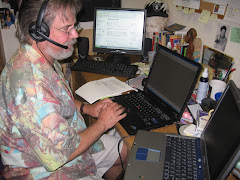This essay into the digital unknown begins with the delightful comic strip Zits, by Jerry Scott and Jim Borgman. In July 24th's three-panel classic, the often stressed mother, still easily shocked by the behaviour of her teenage son, Jeremy, finds him at his computer, listening to a podcast of Thoreau's "Walden" on his iPod while playing a video game. In response to her cry of anguish, he comments pithily: "Nobody ever died of irony, mom!"
At one level, this reminds me not to be concerned about the reception conditions pertaining to those to whom our new online course will be delivered. After all, we should perhaps be glad that Jeremy is being exposed to the wisdom and experiences of the radical and profound Henry David and less concerned about the circumstances of that exposure. So why do I find myself obsessing, long before we are ready to launch our on-line course, about those who will be at the receiving end, their manner of attending to the material and their responses, both initial and considered?
Perhaps because in the classroom, I have constant and immediate feedback through auditory and visual channels. As my students engage in an interactive group task, for example, I can discreetly scan the room, eavesdropping on snatches of discussion, watching body language, monitoring patterns of interaction. It’s highly clichéd, but I can keep my eye on them, keep an ear to the ground. And while my students are encouraged to bring healthy snacks and to keep themselves well hydrated and some bring their laptop, I can count on a very high level of attention and engagement and a minimum of distractions.
The on-line student, in contrast, is a multi-tasking, totally distracted wreck: my fervid imagination pictures individuals in bathrobe, woolen hat and gloves (northern latitudes) or sweaty, wrinkled underwear (more tropical climes), eating pizza or milk-soaked cereal, guzzling iced coffee or pina coladas, doing laundry, babysitting, baking cookies, doing the crossword puzzle, arguing with a significant other. The technologically accomplished have two or three active windows in addition to our course, chatting with close friends, viewing on-line porn, reading reviews of the latest book about Princess Diana. My favourite nightmare features a student sitting in a completely different course, laptop in place, responding to our prompts in the dull parts, minimising our window when the current business in the room requires attention. Minimising, for heaven's sake! A related haunting fear is a desk-bound clerk or junior administrator with dreams of an international career in English language education, sneaking onto the Moodle during idle moments and covertly completing a task or two.
Not my business. Absolutely not my business. There may well be one and three quarters cups of irony in the mixing bowl of this course: it's largely about precise and effective communication, and it will be deployed in a mist of vagueness and uncertainty around the conditions of the communication among participants. I may feel like a voice crying out into the darkness, like a Robinson Crusoe tossing bottled messages into the digital tides. I may long for human contact, seeking a Friday avatar in the remote corners of Second Life.
But Jeremy is right: it won't kill me.






